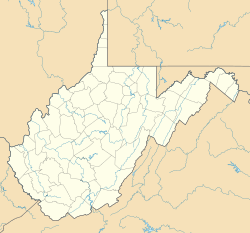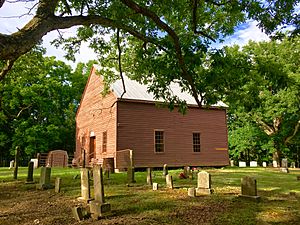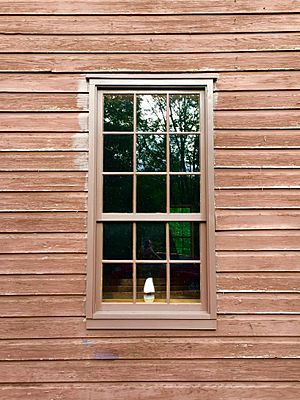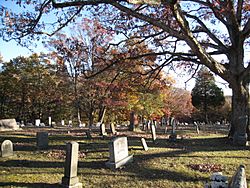Old Pine Church facts for kids
Quick facts for kids |
|
|
Old Pine Church
|
|
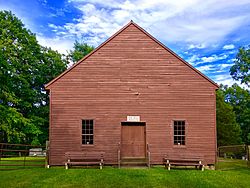
Front of the church
|
|
| Location | Old Pine Church Road (West Virginia Secondary Route 220/15) Purgitsville, West Virginia, United States |
|---|---|
| Area | 2.3 acres (0.93 hectares) |
| Built | 1838 |
| Architectural style | Front gable |
| NRHP reference No. | 12001049 |
| Designated | December 12, 2012 |
Old Pine Church, also known as Mill Church, Nicholas Church, and Pine Church, is a historic church. It was built in the mid-1800s near Purgitsville, West Virginia, United States. It is one of the oldest log churches still standing in Hampshire County. Other old log churches include Capon Chapel and Mount Bethel Church.
The church was built in 1838. It was meant to be a "union church" for different Christian groups. Many early settlers in the Mill Creek valley were from Germany. So, Old Pine Church might have been a meeting place for "Dunkers" or "Dunkards," who were part of the Schwarzenau Brethren. German Methodist settlers also used the church.
By 1870, the Brethren group mainly used the church. In 1878, the church's members split into two groups. These were the White Pine Church of the Brethren and the Old Pine Church. Both groups continued to use the church until 1907.
Old Pine Church also had a school in the early 1900s. It was still used for worship at that time. In 1968, people in Purgitsville raised money to fix up the church. It was added to the National Register of Historic Places on December 12, 2012. This was because it showed important early religious building styles in the Potomac Highlands.
The church is a large, one-story building made of logs. It has a pointed roof at the front. The outside is covered with brown wooden siding. You can still see the original log beams under the church. Some of the bark is even still on the logs. Inside, the ceiling is about 15 feet high. It is covered with metal panels that look like tin. Some of the church's benches are from 1857. In the cemetery next to the church, the oldest gravestone is from 1834. Some unmarked graves might be from as early as 1759. An expert named Sandra Scaffidi said Old Pine Church and its cemetery are a great example of early church areas.
Contents
Where is Old Pine Church?
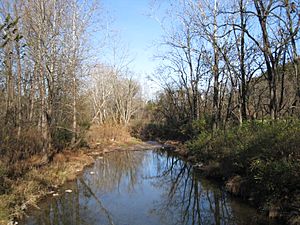
Old Pine Church and its cemetery are on Old Pine Church Road. This road is very steep. The church is about 1.66 miles south of the small town of Purgitsville. The church and cemetery sit on 2.3 acres of land. They are on a hill west of United States Route 220. The church is about 1,129 feet above sea level. Old forests surround the property.
The church is in a country area of southwestern Hampshire County. It is in the Mill Creek valley. Patterson Creek Mountain is a forested mountain ridge to the west of the valley. The forested hills of Mill Creek Mountain are to the east. The Trough on the South Branch Potomac River is about 3 miles east of the church.
History of Old Pine Church
Early Land and Settlers
The land where Old Pine Church stands was once part of a huge land grant. This grant was called the Northern Neck Proprietary. King Charles II gave this land to his supporters in 1649. Later, the land passed to Thomas Fairfax, 6th Lord Fairfax of Cameron in 1719.
The church is in the Mill Creek valley. Lord Fairfax wanted more white settlers to move to his land. The valley was one of the first places in Hampshire County to be settled. People started moving there in the mid-1700s. They liked the valley because the land was good for farming. As more people came, the town of Purgitsville grew. It became a trading post village along Mill Creek. It was named after Henry Purgitt, who bought land there in the late 1700s. Purgitsville grew to have a small store, a post office, and a blacksmith shop.
Building the Church
No one knows for sure when the first church building was built. It might have been around 1814, or even as early as 1792.
On September 24, 1838, William and Milly Pomkrotz gave land to a group of people. These people were in charge of building "a church or house for public worship." It was meant for "Ministers and others of the Christians Denominations Whatsoever." The paper mentioned an old meeting house on the land. But there is no proof of an earlier building.
According to historian Sandra Scaffidi, no single Christian group owned the church. This means it was likely a "union church" for different groups. The first minister was reportedly Nicholas Leatherman.
Brethren Church Use
Not many records exist about the church's early history. This might be because no single group owned it. Several Christian groups met at Old Pine Church. The Schwarzenau Brethren (also called German Baptist Brethren) started holding services there in the late 1800s. Many settlers in the Mill Creek valley were German. So, Old Pine Church might have been built for the Brethren, who were also called "Dunkers." German Methodists are also thought to have used the church.
The Brethren are a Christian group. They believe in baptism by dipping a person into water three times. This is called "triune immersion." They also believed in being peaceful and not fighting. The Brethren only followed the New Testament and had no other beliefs written down. The inside of Old Pine Church is one big open room. This shows its connection to the Brethren. They believed that all worshippers were equal. The Brethren also did not believe in owning slaves. Many people in Hampshire County owned slaves before the American Civil War. But Brethren members in the county likely did not.
The Brethren group had been in the South Branch Potomac River valley since the 1750s. But early records are missing. Old Pine Church was part of the larger Beaver Run congregation. This group was about 10 miles south of Old Pine Church. Old Pine Church was probably used by Beaver Run members. The distance was too far for them to travel easily. So, Old Pine Church started as a smaller church for the Beaver Run group. It served people in both Hampshire and Hardy County.
By 1870, the Brethren group mainly used Old Pine Church. The Nicholas congregation of Brethren met there. Dr. Leatherman led them. In 1879, 78 members were at Old Pine Church. By 1881, there were 100 members. The Beaver Run group changed its area in 1879. This might have split the Old Pine Church members into two groups. These were White Pine Church of the Brethren and Old Pine Church. Both churches continued to worship at Old Pine Church at different times. White Pine Church of the Brethren used the church until they built their own in 1907. By 1897, Old Pine Church was still owned by several Christian groups. But the Brethren were the largest group.
Old Pine Church also had a school in the early 1900s. It was still used for worship. A small room was added to the church for the teacher to live in. Old Pine Church was also used for funerals and family gatherings.
Restoration and Current Use
In 1968, people in Purgitsville raised money to fix up Old Pine Church. The original windows were fixed. The outside wood was painted. A new roof was put on, and the old wood floor was replaced. The teacher's room was likely removed. The metal ceiling might have been added then.
As of 2012, Old Pine Church is still used for community events. These include funerals, special religious meetings, and one church service each year. Regular church services have not happened there since the mid-1900s. The cemetery next to the church is still used for burials. Old Pine Church has been known by many names. These include "Mill Church," "Nicholas Church," and "Pine Church."
In 2008, local groups started a project. They wanted to add historic places in Hampshire County to the National Register of Historic Places. Old Pine Church was one of the first eight places considered. Churches are not usually chosen for the register. But Old Pine Church and Capon Chapel were special. They both started as meeting houses for different groups. Old Pine Church was added to the National Register of Historic Places on December 12, 2012. This was because of its important early religious building style.
Church Building Details
Outside of the Church
Old Pine Church is a large, one-story building made of logs. It has a pointed roof at the front. The front of the church faces west. It has a main entrance with two sets of four-paneled doors. Two concrete steps lead up to the entrance. There is a metal handrail on each side. Above the entrance, a small white wooden sign says "Old Pine Church" in black letters. On each side of the doors are two wooden windows. These windows have nine small glass panes on top and six on the bottom.
The north and south sides of the church also have two of these wooden windows. On the north side, between the two windows, is an outside concrete block chimney. The back of the church, facing east, also has three windows. The middle window is placed above the other two. The church's windows have been fixed using materials like the original ones.
At the bottom of each of the church's four corners is a large, uncut stone. Smaller Fieldstones were added around the church's base later. This was to keep animals out. You can see the original log beams under the church. Some bark is still on them. The church is covered with brown wooden siding. It has a modern metal roof.
Historian Sandra Scaffidi says the church's simple design shows what materials early settlers had. It is an example of how early religious buildings were made from logs in Hampshire County. She also says it is a great example of an early church complex in the area.
Inside of the Church
The inside of the church is one open space. A simple wooden pulpit stands against the back wall, under the middle window. The floor is made of pine boards. These were put in during the church's repairs in 1968.
The ceiling is about 15 feet high. It is covered with pressed metal panels. A small opening lets people get into the attic. The window frames inside are plain. They are about 1 foot deep. The inside walls are covered with plasterboard, but they are not painted.
The church's small wood-burning stove was once in the middle of the room. Later, it was moved to the north wall. It is still the only way the church is heated.
Several of the church's benches are from 1857 and are still used. The benches are very simple. Each has a long wooden seat. The backrest is a thin rail supported by three small posts. The benches are held up by three curved supports. These are joined to the seat with special joints and nails. Newer benches look the same. But they are built with modern nails and wood. Most benches are arranged facing the front of the church, with an aisle in the middle. Two benches are along the north wall, and four are along the south wall. The pulpit is at the east end. There is an upright piano in the northeast corner of the church.
Cemetery
Old Pine Church is surrounded on three sides by a cemetery. About 200 people are buried there. The oldest part of the cemetery is right next to the church. The oldest gravestone still standing is from 1834. But some unmarked graves might be from as early as 1759. A sign for the church on U.S. Route 220 incorrectly says the oldest graves are from 1792.
The headstones in the cemetery face both east and west. Most are simple. They have birth and death dates carved into them. They are made of rounded, arched, or rectangular stones. Some are pyramid-shaped. They seem to be cut from limestone. In the southern part of the cemetery, there are small rectangular stones. These are probably footstones. After about 1950, the gravestones became more detailed. They have polished granite tops on rough stone bases.
Old Pine Church's cemetery has several old trees around it. A large oak tree hangs over the southwestern part of the cemetery. Another piece of land was bought around 1950 for more burials. This land is outside the historic area. A chicken wire fence with wooden posts surrounds the cemetery. A large gate to the north of the church lets machines into the cemetery.
See also



